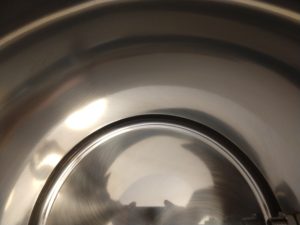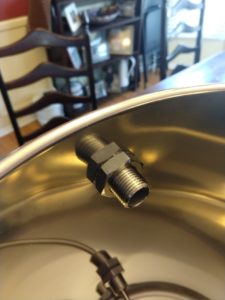
Hands on Review: Chapman Thermobarrel Stainless Steel Mash Tun

Updated: March 6, 2025
This review is by Homebrew Finds Contributor Brad Probert. Brad is an engineer, expert homebrewer and experienced reviewer. Grab a link to Brad’s website at the end of this review.
Chapman Thermobarrel
Coolers being used for mash tuns are quite common in the homebrew world. This makes sense because they are some common household gear that can be easily repurposed for homebrew use, and they do a great job doing what you need while mashing- hold temperature steady. Steady mash temperatures gets you on the path to repeatability. And no one likes brewing with an “I don’t know we’ll see if this turns out” approach.
 1-inch Thick Insulated Walls
1-inch Thick Insulated Walls
The Chapman Thermobarrel is essentially just like a big Gatorade drink cooler, but instead of the insulation being wrapped in hard plastic, it’s skinned in stainless steel. The stainless skin makes it easy to clean and sanitize, and you don’t have to worry about long-term discoloration or scratches in the plastic. The insulated walls are 1” thick, and the base and lid have just under 1” of insulation or insulating air gap.
Check Current Pricing and Availability:
- Chapman 10 Gallon ThermoBarrel Stainless Steel Mash Tun
- Search Amazon for “Thermobarrel” – offerings vary
This article contains affiliate links. We may make a small percentage if you use our links to make a purchase. You won’t pay more and you’ll be supporting Homebrew Finds and more content like this. Thank you for your support!
The lid is engineered to keep the heat in. The internal stainless sleeve extends up about an inch, and the lid nests over the top of this with a nice thick, compliant silicone seal. With 3 latches around the outer edge of the lid, it pulls it down onto this seal for an airtight fit. Definitely more robust than a plastic spin-on drink cooler lid for cutting off heat-escaping air paths. Also on the outside are two solidly welded steel handles- sturdy enough to move the mash tun around if needed when full of grain/wort.
 Bottom of Tun with False Bottom Installed
Bottom of Tun with False Bottom Installed
The false bottom in the mash tun is a simple steel circular plate, domed up in the middle. There are rows of small holes across its full area, and in the center there’s a 90-degree elbow fitting held in place by a nut on the bottom side. There’s a barbed end on one end of this elbow, then a short length of high temp hose connects this to a barbed fitting on the ball valve drain. The grain sits on top of this domed plate, and the elbow fitting in the center pulls liquid from underneath the dome, passing it through the tubing and out the ball valve.
 Domed False Bottom- Assembled
Domed False Bottom- Assembled Easy to Read Thermometer
Easy to Read Thermometer
Halfway up the side of the mash tun, there is a large dial thermometer, with a thermowell that extends in toward the middle of the mash tun. It sits at a level that requires just over 5 gallons of water to submerge it.
Hands on Review
 Polished Surface on Inside
Polished Surface on Inside
The finish and build quality was very good. The gauge of the stainless seemed to be just right to provide a reasonably durable shell, but not make the whole thing so heavy that cleaning it turned into a gym workout. The finish was nice and shiny, but not over-polished. The only finish item that stood out was the edges of the false bottom. The trim line of the false bottom cut through several of the small perforation holes along its circumference, and where it did, it made some rough edges. I was concerned for the potential of this to scratch the smooth inner surface of the mash tun during washing, but that was not the case. I had no scratch issues while removing and reinstalled the false bottom.
 Chapman Thermobarrel in RIMS Setup
Chapman Thermobarrel in RIMS Setup Inside of Mash Tun- Recirc, Thermowell, Outlet
Inside of Mash Tun- Recirc, Thermowell, Outlet
For my full-batch brewing trial, I used the Chapman mash tun with a RIMS Rocket [Review], continually recirculating wort. The pre-installed recirculation port was obviously handy for this. I just removed the plug and added a fitting to go with my camlock connections. You might wonder what the point of an insulated mash tun is in a RIMS setup, but there were two benefits. The first was more uniform/stable temperature through the body of the mash, as it wasn’t losing heat continually from top to bottom. The second was with a multi-step mash profile, the time to heat up was faster. The Blichmann RIMS Rocket 120V has a 2000W coil, and on my typical mash tun setup with a heavy-gauge Spike kettle, I would get temperature rise of 1.8 degrees/minute. Using the same setup but with the Chapman Thermobarrel, I got a 33% faster heating time, going up to 2.4 degrees/minute. Even if doing a single step mash, heating the strike water 100 degrees becomes a 42-minute affair rather than 56 minutes. And that’s significant to me.
For those not using it with a RIMS system and are instead heating strike water to dump in, add the grain, and seal it up, I did a couple experiments with that. I use Brewfather [Review] as my brewing software, and I did the test to calculate the mash tun heat capacity so it could calculate the heat sucking character of the tun. It calculated out to 2.79 L equivalent volume, for those that use that software. I did a mash trial without a RIMS, where I heated 3.5 gallons of strike water to 183F, then combined that with 9 lbs. of grain for a 1 hour mash. Filling the mash tun a little less than half full, it stabilized at 156F after mashing in. I put the lid on, and didn’t open until 1 hour later, where it read 154F. There are tricks to get even better stabilization, like pre-heating the mash tun first, and then adding strike water + mash. But I’m not one for complicated process, and this temperature performance with a half-empty mash tun is far better than what I’ve experienced in my old 5-gallon cooler mash tun, so I’d say this result completely met my needs.
The false bottom seemed very simplistic and I wasn’t sure how well it would work. No fancy clips or ledges, just the simple dome shape sitting at the bottom. But I was impressed. It did a great job at filtering the mash and I didn’t have problems with a stuck mash or with lots of grain bits passing through into the boil kettle. And although mash efficiency is dependent on so many variables that it has little meaning on its own, I achieved a mash efficiency of 80% using this with my RIMS setup. And when it came time to cleaning, the simple false bottom was great. It came out easily for fast cleaning of the false bottom and the bottom of the mash tun. One thing that was not present on the inside that would’ve been nice, is volume markings.
 Thermowell Cavity – Be Sure to Clean
Thermowell Cavity – Be Sure to Clean
The thermometer mounted into the thermowell was super clear to read. The downside was that it was mounted halfway up, so it didn’t get submerged until there were 5 gallons added to it. I brewed a 5 gallon batch of 4.5% ABV beer and the mash just reached it. If you’re planning to do half size batches of 2.5 gallons, you’d have to do full volume mash, or use alternate methods to measure your mash temperature. The thermowell fitting on the inside created a pocket that looked like it would be prone to getting grains stuck in it, but that didn’t happen. I was able to spray it with hot water sufficiently during cleaning to get what seemed to be any stowaway grain particles rinsed out. But definitely something you should pay attention to when cleaning.
Conclusions
 Weldless Fitting for Outlet Ball Valve
Weldless Fitting for Outlet Ball Valve
Overall, the quality of the Chapman Thermobarrel was very good. The simplistic false bottom made for very easy cleaning, yet still supported good mash conversion efficiency. The temperature holding performance was impressive both as an infusion mash tun, but also in a RIMS setup. Obviously more expensive than a plain cooler mash tun, but more affordable than other insulated stainless mash tuns on the market, it provides an option in between for you.
Check Current Pricing and Availabilty:
- Chapman 10 Gallon ThermoBarrel Stainless Steel Mash Tun
- Search Amazon for “Thermobarrel” – offerings vary
Related Reviews:
- Hands on Review: Blichmann Engineering RIMS Rocket
- Hands on Review: Brewfather App – Recipe Formulation, Calculators & Brew Day Tools
- Hands On Review: Chapman Brewing SteelTank Fermenter
- Hands on Review: Ss Brewtech InfuSsion Mash Tun
More Photos
 Clamps to Latch Lid On
Clamps to Latch Lid On Included Ball Valve and Teflon Tape
Included Ball Valve and Teflon Tape Inner Flange for Lid Sealing
Inner Flange for Lid Sealing![]() Inside of Lid with Silicone Seal
Inside of Lid with Silicone Seal Some Rough Edges on False Bottom
Some Rough Edges on False Bottom Parts of False Bottom Fixture
Parts of False Bottom Fixture Plug for Recirc Port
Plug for Recirc Port Recirc Fitting on Inside
Recirc Fitting on Inside
More Homebrew Finds!
- Last 50 Finds!
- Top Deals – a curated list of the best deals
- Homebrew Reviews – one of the largest libraries of homebrew reviews in existence!
- Our Top Posts – tips, how-tos, resources posts and more
- Let’s be Friends!
Recent Deals!
10 Most Recent Homebrew Resource Posts & How-To’s!
We are Homebrew Review HQ! Our 10 Most Recent Reviews
Special Thanks to Chapman Brewing Equipment for providing the unit used for evaluation in this review.
By Brad Probert. Check out Brad’s website – beersnobby.com
pinnedThis post may contain affiliate links. We may make a commission when you use our links. This will never cost you extra. Thank you for supporting Homebrew Finds!
greatdealsMake sure the components you use are compatible and rated for your intended application. Contact manufacturer with questions about suitability or a specific application. Always read and follow manufacturer directions.
Price, promotions and availability can change quickly. Check the product page for current price, description and availability. tag:lnksfxd review:chaptb tag:tpr




